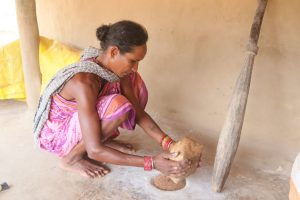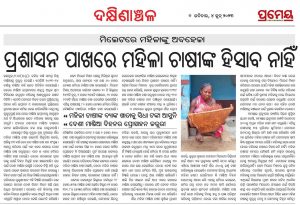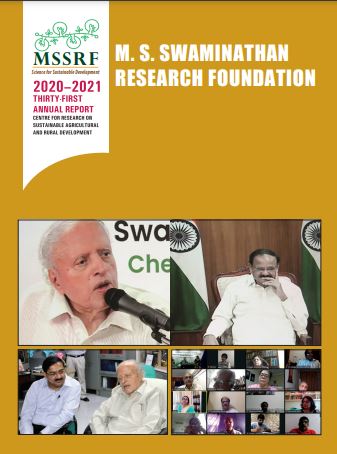Women are neglected in Millet!
This year, the whole world is giving importance to Millets. Even the years 2023–24 have been counted as Millets years. The women who invest the most labour in the production of millets are still visible in the participatory process. Their voice is not heard in their home in the decision-making process. Still, they have not been directly involved in the processes of seed selection, production, and marketing of millets. The most important issue is that even the money coming through millets production does not go directly to their bank accounts. Which keeps them away from issues like equal participation in millet farming.
“Raimati Gihuria, a woman millet farmer of Nuapada village, Kundura block, Koraput district of Odisha, says that she has been associated with millet farming for 13 years today. Earlier, we used to cultivate native millet seeds on an acre of land for the family. Now the area of the farm has increased to 5 acres. But we ourselves do not eat the seeds that are given to us by the government. The native millets seem to be for home consumption. We are cultivating government seeds in the hope of making money by selling them. We are not able to make the decision for seed selection, but the men of the family make this decision. We have many indigenous varieties of seeds that are high-yielding; if the government promotes the cultivation of these, more farmers will be interested in them.
According to the information received from the State Millet Mission, millet is being cultivated on a total of 60 thousand hectares of land in the entire state. Millet, which is locally called mandia, is cultivated in 143 blocks, 2 thousand 275 villages, and 20 thousand 997 villages in 20 districts of Odisha under the Millet Mission. Around 80 thousand hectares of land are being cultivated using various scientific methods. A total of 2 lakh, 1 thousand, 740 farmers are engaged in the cultivation of land using scientific methods, and they have been officially registered under the Odisha Millet Mission. They are also given a financial incentive of Rs 10,000 per hectare for millets cultivation in the government scheme. There has been a tremendous increase in millets production and the amount of land under millets cultivation in the state. Regrettably, the government does not have an account of how many women Millet farmers there are in the state or how many women farmers receive direct financial incentives through millets.

Data collected from the Odisha Millet Mission said that there are a maximum of 28 thousand 535 millet farmers in Koraput district of the state, while it is reported that millet is being cultivated on 11 thousand 320.84 hectares of land. How many women farmers are there in the district, how many are registered under the Odisha Millet Mission, and how many of them are interested in cultivating traditional varieties of millets? The government has no particular data on this. Pratap Chandra Jena, block coordinator of the Odisha Millet Mission, said that only 1939 farmers are cultivating millets in Kundura block, while only 116 women farmers are registered. Which is only 5%.
In this regard, Chandrama Masiha, a woman farmer from Kundura block, Nuaguda village, says: Earlier, my husband and my in-laws did rice on our farm land, and I and my mother-in-law were always interested in cultivating millet, which was helpful in eliminating our food cravings. But now it is the men of the house who are deciding who will grow what kind of crops on the land and when. Last year, we cultivated a native millet variety on half an acre of land, and on the rest, we cultivated government-given millet seed. We made a profit of 30 thousand rupees from that. But this year, my husband decided to plant mung after paddy. So we don’t put millet in anymore. We have planted millet on half an acre of land for our household consumption. We would have gotten support from the family if the government had arranged a special scheme for women millet farmers only.
Millet farmer Sushila Pradhani of Nuaguda village says, “We have set up a producer company in Kundura block for the sale of millet. Under which more than 600 farmers from 25 surrounding villages are listed. Most of them are female farmers. Those who directly labour in all the work, starting from the selection of Millets seeds, planting them in the land, taking care of the land, and harvesting them A woman spent 5 to 7 hours a day cultivating millets. You have to work hard”. She further added that “when the money comes, it comes in the name of the husband, and when the seed distribution time comes, it also distributes to the male member of the family. The empowerment of women that the government is talking about through the Millet Mission is only for a certain category of women. If the government is dreaming about the progress of rural women, then every voice of them is countable. A rural woman should give her opinion. Efforts should be made to grow the native millets.
Prashanta Kumar Parida, development coordinator at the Swaminathan Research Foundation, says; that drought is the most important abiotic stress that affects rice productivity in the southern part of Odisha. Nearly 57% of the total cropped area is now drought-prone. So drought Tolerance is crucial for maintaining a stable yield, especially in a rainfed ecosystem. Substantial dependency on monsoon rainfall makes cultivation in unirrigated areas a high-riskier, less productive farming profession. It is observed that about 80% of the total annual Rainfall takes place due to the southwest monsoon between the middle of June and mid-August October. The northeast monsoon brings erratic and insufficient rainfall. The average annual Rainfall varies between 1320 and 1520 mm. The district is drought-prone because of the erratic and uneven pattern of rainfall. So the farmer in Koraput is cultivating drought-tolerant millets. The great thing is that women know when and where how these varieties grow and how to do so. That’s why they are the real gem of agriculture Practises.
Sushmita Pradhan, CEO of Bamandai Produce Company, says: If we consider the women farmers under the Bamandai Produce Company, it is known that there are actually more than 400 women farmers working under the company, while nearly 75% are homeless. It means they take land on lease from others and cultivate it. And 25% of the women who are cultivating millets on their own land are also doing so in the name of their husbands or fathers-in-law. In other words, women do not have their own land. The problem with this process by the government is that the women farmers do not have any land, and due to their lack of land, they cannot be registered in Millets, and therefore the money earned from the harvest does not reach them.
This situation poses a significant problem as these women farmers are unable to register themselves in the Mandi (marketplace), which results in their being excluded from the financial transactions associated with the harvest. Consequently, the money earned from their agricultural efforts does not reach them, perpetuating their financial instability and dependence.
It is evident that the lack of land ownership among women farmers hinders their economic empowerment and restricts their ability to participate fully in the agricultural sector. Addressing this issue requires implementing measures that provide land rights and ownership to women, enabling them to have control over their farming activities, and ensuring that they receive the financial benefits they rightfully deserve.
State Millet Mission Joint Secretary Sailendra Mohanty said that the government wants to improve millet by taking in rural women. For this, Chief Administrative Secretary Arvind Padi has given instructions on how to issue an SOP as soon as possible for the preservation of traditional military In the coming days, we will definitely give importance to women farmers and identify them.
This article first published in Prameya Newspaper on June 04, 2023


